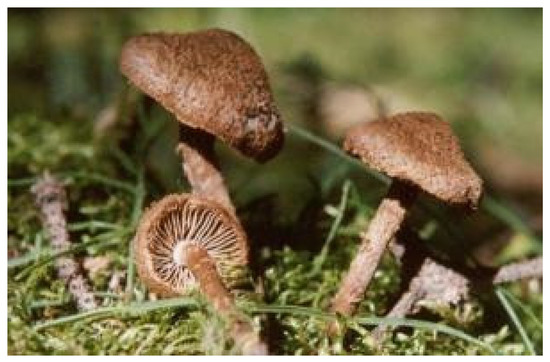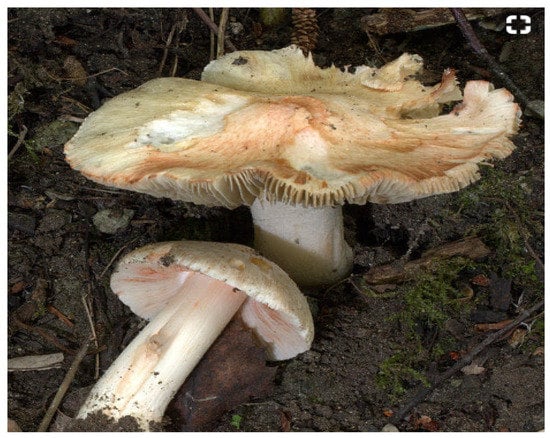Mushroom poisoning has always been a threat to human health. There are a large number of reports about ingestion of poisonous mushrooms every year around the world. It attracts the attention of researchers, especially in the aspects of toxin composition, toxic mechanism and toxin application in poisonous mushroom. Inocybe is a large genus of mushrooms and contains toxic substances including muscarine, psilocybin, psilocin, aeruginascin, lectins and baeocystin. In order to prevent and remedy mushroom poisoning, it is significant to clarify the toxic effects and mechanisms of these bioactive substances.
- Inocybe Mushrooms
1. Introduction
Poisoning incidents caused by ingesting poisonous mushrooms occur every year all over the world, and a large number of poisoning incidents have been reported. Accidental poisoning by foraged mushrooms can affect health or even lead to death in some cases. Mushroom poisoning is a worldwide food safety issue and it has been one of the main causes of food poisoning deaths.
In recent years, more than 100 kinds of poisonous mushrooms have been found, of which more than 30 have fatal toxicity. Among the many poisonous mushrooms, the genus Inocybe are common poisonous mushrooms. Many species of the genus Inocybe, a highly diverse genus of ectomycorrhizal Agaricales, are world-wide mycorrhizal mushrooms. At present, we mainly distinguish edible fungi and toadstools by morphology, but Inocybe mushrooms are often confused with edible species because of their similar appearance, which is also often the cause of mushroom poisoning [1]. People and animals may show some toxic symptoms after ingesting these mushrooms. The main toxic substances of these fungi are muscarine, psilocybin and psilocin. They act primarily on the central nervous system and may cause a range of neurological symptoms. Muscarine increases parasympathetic tone by M-type of post-ganglionic parasympathetic receptors located in muscles and glands, and it causes parasympathetic nervous excitement, heart rate slows down and weakens, muscle contractions, increased gland secretion and pupils become constricted. Furthermore, it can act on the central nervous system and cause nerve excitement [2]. Muscarine is fatal to human beings if too much is ingested at once. According to the available data, the human lethal dose of muscarine in the aforementioned mushrooms is about 500 g of raw mushroom. However, 10 to 20 g of raw mushroom is enough to lead to poisoning [3]. Thus, eating a small number of poisonous mushrooms by mistake is very likely to be poisonous.
Psilocybin and psilocin are neurohallucinogenic toxins and they cause people to experience hallucinations, uncontrollable laughter, extreme excitement and other strange feelings after ingestion. Therefore, they are also known as “laughing mushrooms” and are banned in many western countries as drugs because of these strange neurological symptoms.
Although these toxins have toxic effects and may threaten human life and health, they have been applied to scientific research and biomedicine with the development and maturity of scientific research. Psilocybin and psilocin, particularly, are widely used in the treatment of neurological diseases, drug addiction and psychotherapy due to their mild toxic effects. Psilocybin and psilocin can change the state of neuroconsciousness and reduce anxiety and depression in psychiatric patients. They are also used as a treatment for Alzheimer’s disease, schizophrenia and other mental and psychiatric disorders. Due to their low toxicity and short duration of action, they are often used as a drug substitute for drug treatment to reduce the pain and dependence of drug addicts.
Mushroom poisoning is closely related to people’s health and life, so it is of great significance to understanding toxic components and toxic types of poisonous mushrooms for prevention and treatment of mushroom poisoning. In this review article, we summarized the chemistry, most known toxic effects and mechanisms of major toxic substances in Inocybe mushrooms, especially muscarine, psilocybin and psilocin. We also discuss the treatment and applications of these toxins. It is hoped that this review can help us to better understand the main bioactive substances and the clinical application of Inocybe, so as to provide some reference for toxin related researchers.
2. Mycology
Inocybe is a large genus of mushrooms in the order Agaricales and family Cortinariaceae (Figure 1). Index Fungorum includes 848 species in Inocybe [4]. The genus Inocybe (Inocybaceae) has a wide distribution in temperate and tropical regions of the Northern Hemisphere. As for morphological characteristics, the fruiting bodies are small. The cap is deep cinnamon-brown to rust-brown oblate with hairy scales, up to 4 cm in diameter and have margin without cracks. Mushroom meat is white and its fold is straight to nearly extended, light rust color, with white fold margin. The mushroom has a cylindrical almost-white stipe. Its ecological habit is to grow in groups in forests. Ryberg and collaborators considered that large parts of Inocybe taxonomy and evolutionary history remain poorly explored [5]. As new species of Inocybe mushrooms are discovered, some confusion around this group of mushrooms is quite understandable.

Figure 1. Inocybe mushrooms.
3. Inocybe Poisoning
Inocybe mushrooms contain toxic substances, which can cause poisoning at low dose. Due to the similar appearance to many edible mushrooms, they are often eaten by humans and animals by mistake. Published reports of poisoning with Inocybe poisonous fungi are limited to intoxication of dogs and humans.
3.1. Animal Poisoning
In general, the number of reported animal poisonings is relatively low. Toxicology testing is only available for a limited number of fungal toxins. Three cases of dog poisoning with Inocybe asterospora Quel were recorded in China [6][7], and five cases were recorded in Norway [8]. Common clinical findings in dogs were diarrhea, vomiting, ptyalism and tachycardia. The results of the therapy have shown that the prognosis of Inocybe poisoning is very good. All dogs only fully recovered after supportive care.
3.2. Human Poisoning
Poisoning by people with Inocybe mushrooms is not very common. The diagnosis uses the clinical picture and anamnestic data, mycological and toxicological examination of the residues of mushrooms, their spores and toxins [9]. Several published reports of poisonous Inocybe mushrooms were often limited by insufficient identification of the species [1]. Inocybe erubescens (syn. I. patouillardii) (Figure 2) is the most common type of Inocybe associated with toxicity in Europe. Other poisoning of humans was reported in species Inocybe fastigiata [10], Inocybe tristis [11], Inocybe asterospora [7], and Inocybe aeruginascens [12].

Figure 2. Inocybe erubescens, the most common Inocybe species associated with toxicity in Europe.
Although awareness of poisonous mushrooms is increasing, hospitals annually treat many patients diagnosed with poisoning by toxic fungal species. Inocybe fungal poisoning has been reported in India in 2015 [13]. A total of 11 people were poisoned, including a 6-month-old child. All those treated were hospitalized. Respiratory distress, vomiting, diarrhea and visual disturbances were observed. It is not known how they were treated, but everyone was released from hospital the next day after intoxication. Tropical Inocybe carnosibulbosa CK Pradeep & Matheny, previously unknown in India, have been identified as the cause of poisoning [14]. In 2019 in the province of Ningxia in China, two patients exhibited typical muscarinic symptons after consuming wild mushrooms. The clinical manifestations included chills, sweating, salivation and diarrhea. The incubation period was approximately 2 h. After emergency treatment, they recovered 24 h later. The specimen was identified as Inocybe serotina and muscarine was detected [15]. In China, one of the food poisoning accidents in Panyu City, Guangdong province, attracted people’s attention. Ten migrant workers on a construction site ingested mushrooms which grew on cow dung as their dinner. After eating for about 5 min, some people experienced nausea, dizziness, headache and limb weakness. Two hours later, all the workers had the same symptons. The doctor immediately induced emesis, gastrolavage, activated carbon adsorption and other emergency measures; all the workers recovered and were discharged 3 d later. Experts determined that the cause of poisoning was the psilocybin contained in the mushrooms they ate.
The latency to first signs of poisoning varies between 15 min and 2 h after consumption. Clinical manifestations include nausea, vomiting, abdominal pain, diarrhea, hypersalivation, diaphoresis, hypotension, tearing, blurred vision, miosis, tremors, restlessness, flushing and syncope. Additionally, this sickness has a good prognosis after supportive treatment, including intravenous fluids, antiemetics and 1 mg atropine intravenously. Full recovery is usually within 12 h [16].
This entry is adapted from the peer-reviewed paper 10.3390/ijms22042218
References
- Lurie, Y.; Wasser, S.P.; Taha, M.; Shehade, H.; Nijim, J.; Hoffmann, Y.; Basis, F.; Vardi, M.; Lavon, O.; Suaed, S.; et al. Mushroom poisoning from species of genus Inocybe (fiber head mushroom): A case series with exact species identification. Clin. Toxicol. 2009, 47, 562–565.
- Hasuo, H.; Akasu, T.; Gallagher, J.P. Muscarine activates a nonselective cation current through a M3 muscarinic receptor subtype in rat dorsolateral septal nucleus neurons. J. Neurophysiol. 1996, 76, 2221–2230.
- Klaassen, C.D.; Casarett, L.J.; Doull, J. Casarett and Doull’s Toxicology: The Basic Science of Poisons, 8th ed.; McGraw-Hill Education: New York, NY, USA, 2013; ISBN 9780071769235.
- Kirk, P.M. Species fungorum (version 20 November 2015). In Species 2000 & ITIS Catalogue of Life; The Catalogue of Life Partnership: Leiden, The Netherlands, 2019.
- Ryberg, M.; Kristiansson, E.; Sjökvist, E.; Nilsson, R.H. An outlook on the fungal internal transcribed spacer sequences in GenBank and the introduction of a web-based tool for the exploration of fungal diversity. New Phytol. 2009, 181, 471–477.
- Puschner, B.; Wegenast, C. Mushroom poisoning cases in dogs and cats: Diagnosis and treatment of hepatotoxic, neurotoxic, gastroenterotoxic, nephrotoxic, and muscarineic mushrooms. Vet. Clin. N. Am. Small Anim. Pract. 2018, 48, 1053–1067.
- Lin, H.T. Mushroom poisoning (Inocybe asterospora Quel.)—Report of 3 cases. Zhonghua Yu Fang Yi Xue Za Zhi 1984, 18, 231–233. (in Chinese).
- Seljetun, K.O.; von Krogh, A. Acute Inocybe mushroom toxicosis in dogs: 5 cases (2010–2014). J. Vet. Emerg. Crit. Care 2017, 27, 212–217.
- Kohn, R.; Mot’ovská, Z. Mushroom poisoning--classification, symptoms and therapy. Vnitr. Lek. 1997, 43, 230–233. (in Slovak).
- Wilson, D. Poisoning by Inocybe fastigiata. Br. Med. J. 1947, 2, 297.
- Amitai, I.; Peleg, O.; Ariel, I.; Binyamini, N. Severe poisoning in a child by the mushroom Inocybe tristis, Malençon and Bertault. Isr. J. Med. Sci. 1982, 18, 798–801.
- Gartz, J.; Drewitz, G. The green discolored mushroom Inocybe aeruginascens--an Inocybe species with hallucinogenic effects. Z Arztl Fortbild 1986, 80, 551–553. (in German).
- Pradeep, C.K.; Vrinda, K.B.; Shibu, P.V.; Hailee, B.K.; Brandon Matheny, P. New species of Inocybe (Agaricales) from tropical India. Mycol. Prog. 2016, 15, 2–25.
- Bijeesh, C.; Vrinda, K.B.; Pradeeo, C.K. Inocybe poisoning in Kerala—A case study. J. Mycopathol. Res. 2020, 57, 255–258.
- Xu, F.; Zhang, Y.Z.; Zhang, Y.H.; Guan, G.Y.; Zhang, K.P.; Li, H.J.; Wang, J.J. Mushroom poisoning from Inocybe serotina: A case report from Ningxia, northwest China with exact species identification and muscarine detection. Toxicon 2020, 179, 72–75.
- Beuhler, M.C. Overview of mushroom poisoning. In Critical Care Toxicology: Diagnosis and Management of the Critically Poisoned Patient; Brent, J., Burkhart, K., Dargan, P., Hatten, B., Megarbane, B., Palmer, R., Eds.; Springer: Berlin/Heidelberg, Germany, 2017; pp. 2103–2128.
